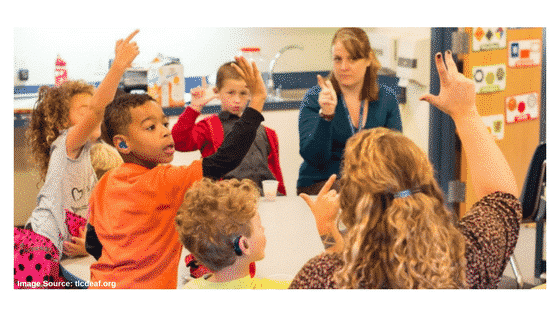
 According to NIDCD (National Institute of Deafness or Other Communication Disorder), about 2 to 3 out of every 1,000 children in the United States are born with a detectable level of hearing loss in one or both ears. And more than 90 percent of deaf children are born to hearing parents.
According to NIDCD (National Institute of Deafness or Other Communication Disorder), about 2 to 3 out of every 1,000 children in the United States are born with a detectable level of hearing loss in one or both ears. And more than 90 percent of deaf children are born to hearing parents.
For parents who only hope for the best, discovering their child is deaf can be heartbreaking and worrisome. Aside from the fact that they need to exert twice the effort in overcoming everyday challenges, especially in communication, raising a deaf child; they also seek assurance that their children (regardless of disability) will thrive in school the way perfectly able kids do.
As Barbara Rice shared in United Federation of Teachers, “not all children with hearing impairments are in self-contained classes. Some teachers will have the opportunity to work with hearing-impaired youngsters in their general education, collaborative team teaching, special education and/or inclusion classes. Depending on the student’s Individualized Education Program, this may or may not include a sign-language interpreter and/or an itinerant Hearing Education Services provider.”
Barbara specialized in teaching hearing-impaired and deaf students, and she shared these tips for teachers who work with hearing impaired and deaf student yet unfamiliar with this population.
- Be sure that the student wears his or her amplification device and you are wearing your microphone.
- Keep in mind that few people are totally Most have some sort of residual hearing, and we want to utilize it fully.
- Make sure your student has preferential seating with a direct view of your face and mouth.
- Don’t yell at your student. Speak in a normal tone. Remember the microphone you have on?
- If your student has an interpreter, then give him or her a copy of the lesson in advance.
- Remember that there is no need to talk to the interpreter.
- Don’t speak while writing on the board.
- Use lots of pictures and graphic organizers. These kids are visual learners.
- Repetition is key, as is the use of hands-on activities.
- Every lesson is a language lesson. Hearing-impaired kids often lack necessary language skills, so every word counts.
(Access the full article here: Teaching children who are hearing-impaired)
Bright Hub Education also published an article on How to Teach Hearing-Impaired Students: Strategies for success!
- Classroom Adaptations
A few easy steps can be taken to ensure the classroom is suitable for hearing impaired students. When possible, turn off equipment that creates background noises, such as fans and projectors, when not in use.
- Communication Considerations
- Look directly at the student and face him or her when communicating or teaching.
- Say the student’s name or signal their attention in some way before speaking.
- Assign the student a desk near the front of the classroom, or where you plan to deliver most of your lectures.
- Speak naturally and clearly. Remember speaking louder won’t help.
- Do not exaggerate your lip movements, but slowing down a little may help some students.
- Use facial expressions, gestures and body language to help convey your message, but don’t overdo it.
- Some communication may be difficult for the hard of hearing student to understand. Explicitly teach idioms and explain jokes and sarcasm.
- Young hearing impaired children often lag in the development of social graces. Consider teaching specific social skills such as joining in to games or conversation, maintaining conversations, and staying on topic.
- Male teachers should keep moustaches well groomed.
See Epic Special Education Staffing Special Ed Teacher Jobs Today
- Visual Strategies and Curriculum Accommodations
- Adjust teaching methods to accommodate your visual learner’s needs by writing all homework assignments, class instructions and procedural changes on the board.
- Arrange desks in a circular pattern if possible so hearing impaired students can see other students. This is especially important if they need to read lips.
- Provide students with an outline of the daily lesson and printed copies of the notes, allowing them to focus on discussions and questions while you are teaching. Students can then be more engaged in learning and can easily review the notes at a later time. Since vision becomes a hearing impaired student’s primary means for receiving information, utilize visual aids whenever you can. Consider using posters, charts, flash cards, pictures, manipulatives, graphic organizers, artifacts or any visual items to illustrate concepts. Try to use captioned videos in class.
- Follow all established guidelines within the student’s IEP (Individualized Education Plan), regarding classroom adaptations and aids for hearing impaired students. Don’t be afraid to contact your school district if you need help.
- Regular Evaluation of Progress
It is critical for teachers to monitor the progress and understanding of all students, but especially so for those with special needs. Teachers must be sensitive to the needs of hearing impaired students and follow the IEP as closely as possible.
- Expect Success
Teaching hearing impaired students doesn’t have to be difficult, as long as you are flexible. When you incorporate these strategies into your teaching practice, chances are that you’ll find a number of students who benefit from your efforts.
And here is another excellent article written by Jeannette Washington, M.Ed. (A former speech-language pathologist, Ms. Washington created Bearly Articulating, a company that provides multisensory tutoring online and in-home, college planning, and professional development to support the unique educational needs of learners struggling in reading, writing, spelling, speaking and other scholastic aspects of formal education.) And Jenna L. Kubly (studied theater history and received a B.A. from Bethel University (Minnesota), M.A. from the University of Colorado-Boulder, and Ph.D. from Tufts University. She is fascinated with all types of history, drama, and art, but especially the society and culture of the First World War. She has published essays and book reviews.)
In their article: Supporting Deaf and Hard of Hearing Students, you’ll learn about;
- Differences: Deaf, Deafness, and Hard of Hearing
- Tech Tools for Deaf or Hard of Hearing Students
- How Schools Create More Audible Environments
- Finding a College that Fits
- Scholarships for Deaf or Hard of Hearing Students
- Schools for Deaf or Hard of Hearing Students
- Additional Resources
- Expert Interviews
We are not affiliated with educators mentioned here. But we thought that they shared constructive ideas that can help you succeed in teaching hearing-impaired and deaf students.
In the end, we all have a common goal; help hearing-impaired and deaf students receive proper education to unleash their full potential!



